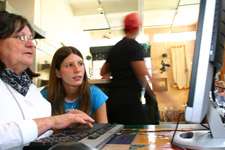50×15 (AMD)
The 50×15 Initiative, launched by AMD in 2004 at the World Economic Forum, aims at providing accessible Internet and computers for 50 percent of the world's population by the year 2015. The initiative includes the deployment of learning labs,[1] which are defined by 50×15 as "deliberate, measured, strategic deployments of technology solutions used to gain insight and knowledge on how best to foster digital inclusion worldwide."
 | |
| Motto | Digital Inclusion with a Deadline. |
|---|---|
| Formation | 2004 |
| Type | For-Profit Organization |
| Headquarters | Austin, Texas |
V.P. | Dan Shine |
| Website | |

Solutions
Solutions include XO laptops (originally named "One Laptop Per Child," OLPC), as well as in-house solutions from AMD, including the Personal Internet Communicator (PIC). In January, assets of the AMD PIC were sold to Data Evolution,[2] which continues to provide the technology in emerging growth markets as the Data Evolution decTOP(tm). Other technologies deployed by 50×15 include low-cost PCs from providers such as HCL and DTK, FIC's Mini PC, the Linutop diskless computer, and more. Note that all solutions use AMD processors, which are typically Geode processors.
Learning Labs
50×15 Learning Labs are strategic deployments of technology solutions used to gain insight and knowledge on how best to foster digital inclusion worldwide. To date, 50×15 partners have implemented more than 30 technology deployments in 12 countries around the world.
Learning Lab deployments must support the following 50×15 ideals:
- Digital inclusion must be about empowerment, not a charity
- Technology must be accessible
- Take a “geo-sensitive” approach to solutions
- An integrated, end-to-end ecosystem needs to be developed for the market
Partners and participants
The 50×15 Partner Program focuses on seven key areas of development, six of which are identified by the ITAFE Global Benchmarking Study.[3] This is referred to as the Digital Inclusion Ecosystem:
- Power – grid based, solar, or manual power generation
- Connectivity – wired, wireless, or satellite service providers
- Devices – servers, personal computers, laptops, thin clients, smart phones, and other tools people use to access the Internet
- Financing – government programs, financial institutions and foundations that provide micro-loans and other means for helping local people afford Internet access tools and services
- Content – locally relevant software applications and information available in multiple languages
- Expertise – training, repair services, and general ecosystem support
- Structure Design – solutions for building sustainable, multi-purpose, low-cost technology facilities
See also
- ASUS Eee PC
- Classmate PC
References
- http://50x15.org/en-us/learninglabs.aspx%5B%5D
- "Archived copy" (PDF). Archived from the original (PDF) on 2007-07-03. Retrieved 2007-07-09.CS1 maint: archived copy as title (link)
- "Archived copy" (PDF). Archived from the original (PDF) on 2007-10-19. Retrieved 2007-12-04.CS1 maint: archived copy as title (link)